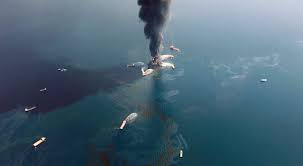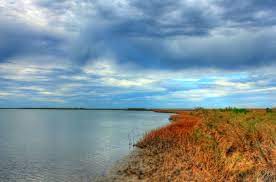The Gulf of Mexico is a large body of water located in the southeastern part of North America. If we look at the Gulf of Mexico Map, tt is bordered by the United States to the north, Mexico to the west and south, and Cuba to the southeast. The Gulf of Mexico is an extension of the Atlantic Ocean and is connected to it through the Florida Straits, which separate Florida from Cuba.

Table of Contents
Key Features
- Geography: The Gulf covers an area of approximately 600,000 square miles (1.5 million square kilometers), making it one of the largest gulfs in the world. It has a roughly oval shape, with its longest axis running from east to west.
- Coastline: The coastline of the Gulf of Mexico is extensive, stretching over 5,000 miles (8,000 kilometers). It includes the southern coast of the United States, the eastern coast of Mexico, and parts of the northern coast of Cuba.
- Oil and Gas Reserves: The Gulf of Mexico is known for its significant reserves of oil and natural gas beneath its seabed. Offshore drilling and exploration activities have been ongoing for decades, making the region a vital source of energy for the United States and other countries.

Oil in Gulf of Mexico - Biodiversity: The Gulf of Mexico is home to a diverse range of marine life, including various species of fish, sea turtles, marine mammals, and numerous types of coral and other underwater habitats.

Animals in Gulf of Mexico - Climate Impact: The Gulf is also susceptible to the formation of hurricanes, particularly during the Atlantic hurricane season, which typically spans from June to November. Warm waters and atmospheric conditions in the Gulf can contribute to the intensification of these storms, which can have significant impacts on the surrounding regions.

Hurricane in Gulf of Mexico - Economic Importance: The Gulf of Mexico plays a crucial role in the economies of the United States and Mexico. It supports various industries, including fishing, shipping, tourism, and energy production.
- Ecological Concerns: Environmental issues, such as pollution, overfishing, and habitat destruction, have raised concerns about the health of the Gulf’s ecosystem. The Deepwater Horizon oil spill in 2010 was one of the largest environmental disasters in history and had a profound impact on the Gulf’s ecology.

Oil Spill 2010 - Cultural Significance: The Gulf of Mexico has been a historically important region for indigenous cultures, European exploration, and trade. It has influenced the development of cultures and economies in the surrounding areas.
Countries bordering Gulf of Mexico
- United States: The northern coastline of the Gulf of Mexico is formed by several U.S. states, including Texas, Louisiana, Mississippi, Alabama, and Florida.
- Mexico: The western and southern coasts of the Gulf of Mexico belong to Mexico. States such as Tamaulipas, Veracruz, Tabasco, Campeche, and Yucatán have coastlines along the Gulf.
- Cuba: The southeastern portion of the Gulf of Mexico is bordered by the northern coast of Cuba.

These countries on Gulf of Mexico Map, collectively share the Gulf of Mexico’s coastal resources and are influenced by its environmental, economic, and climatic dynamics.
Gulf of Mexico Weather
The weather in the Gulf of Mexico region can vary depending on the time of year, but there are some general patterns and characteristics to consider:
- Hurricane Season: The Gulf of Mexico is known for its vulnerability to hurricanes, especially during the Atlantic hurricane season, which typically runs from June 1st to November 30th. Warm ocean waters and favorable atmospheric conditions in the Gulf can lead to the formation and intensification of hurricanes. These storms can bring heavy rainfall, strong winds, and storm surges to the surrounding coastal areas.
- Summer: During the summer months, the Gulf of Mexico experiences warm and humid conditions. Temperatures can range from the mid-80s to 90s Fahrenheit (around 29-35°C). This period is also characterized by increased humidity, which can make the region feel even hotter.
- Fall: In the fall, temperatures begin to moderate, and the risk of hurricanes gradually decreases. The Gulf Coast experiences milder temperatures compared to the peak of summer, making it a popular time for outdoor activities and tourism.
- Winter: Winters in the Gulf of Mexico region are relatively mild compared to many other parts of North America. Temperatures typically range from the mid-50s to 70s Fahrenheit (around 12-25°C), making it a pleasant time to visit. However, occasional cold fronts can bring cooler temperatures and even frost to some areas.
- Spring: Spring is another pleasant time to visit the Gulf of Mexico. Temperatures gradually warm up, and the region experiences moderate humidity levels. This period can also see some variations in weather due to transitional conditions.
- Rainfall: The Gulf of Mexico region receives a significant amount of rainfall, especially during the warmer months. This can lead to occasional thunderstorms and heavy downpours, which can impact local weather conditions and contribute to the risk of flooding.

Weather in the Gulf of Mexico - Local Variations: Weather conditions can vary from one area to another within the Gulf of Mexico region due to local topography, proximity to the coast, and other factors. For example, coastal areas might experience milder temperatures compared to more inland areas.
It’s important to note that weather can be unpredictable, and specific conditions can vary from year to year. If you’re planning to visit or live in the Gulf of Mexico region, it’s a good idea to stay updated on local weather forecasts and any potential advisories, especially during hurricane season.
Overall, the Gulf of Mexico is a complex and multifaceted body of water with significance in terms of economics, ecology, climate, and culture. It continues to play a vital role in the lives of the people who live around its shores and in the broader context of the global environment.
Thanks for reading the article on Gulf of Mexico Map [Countries].
Read:




